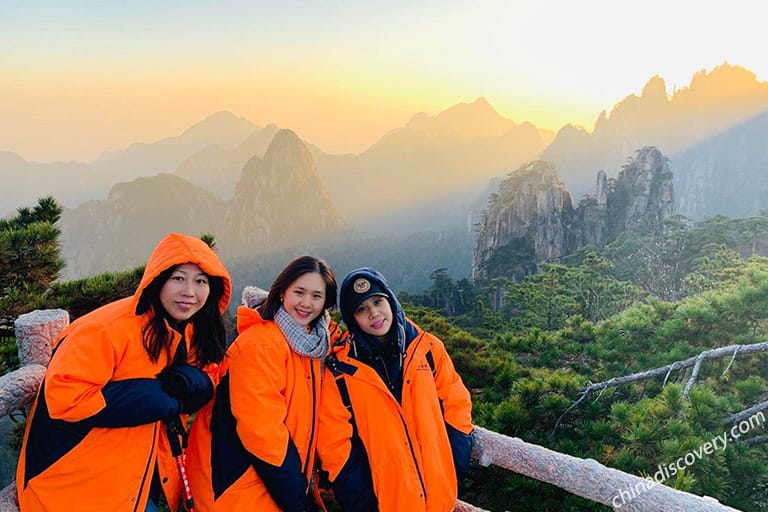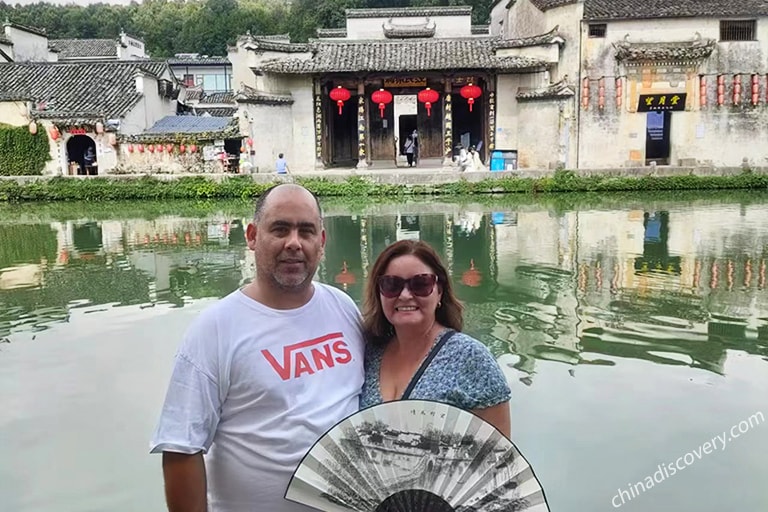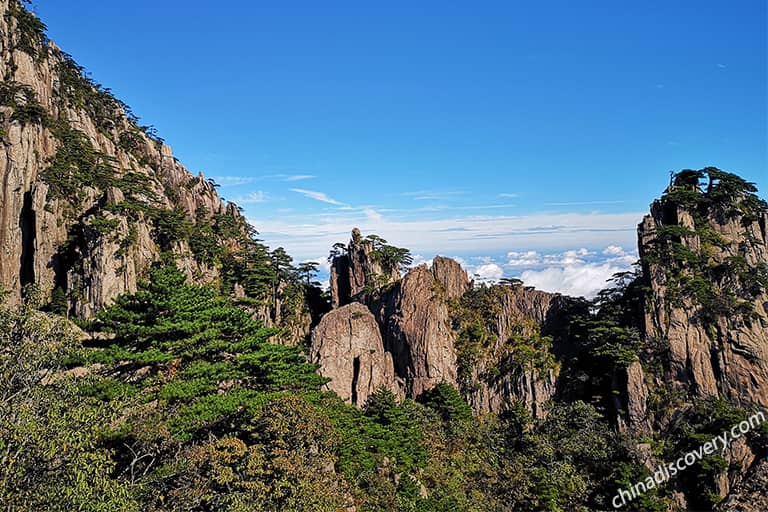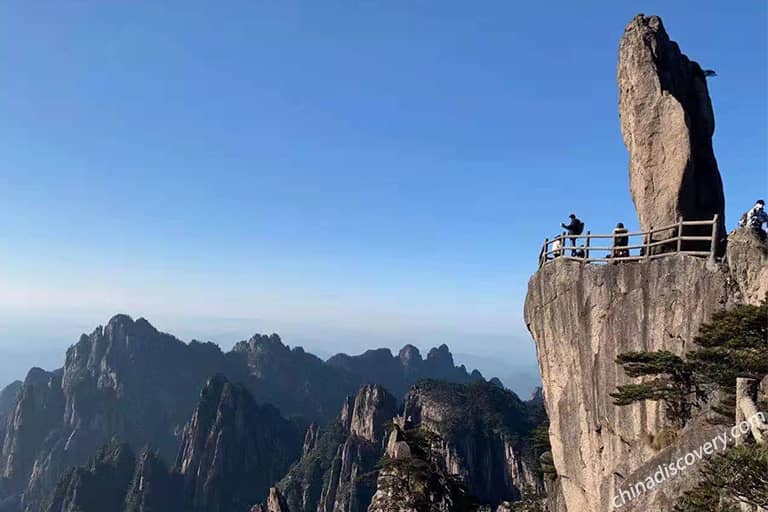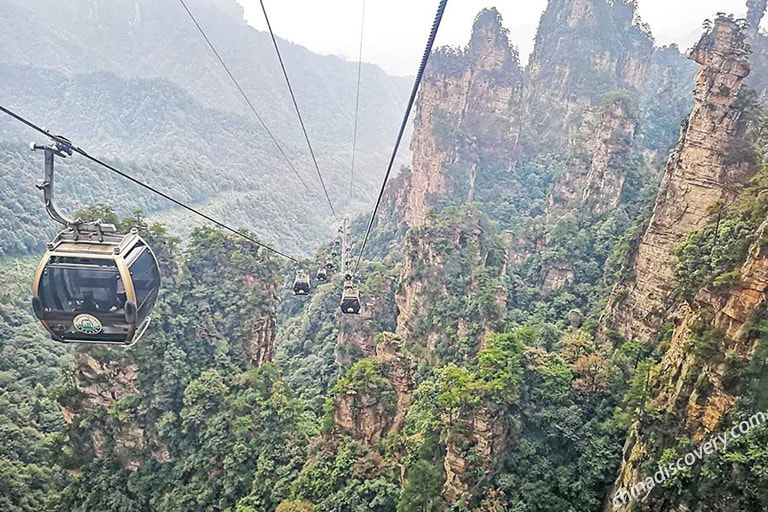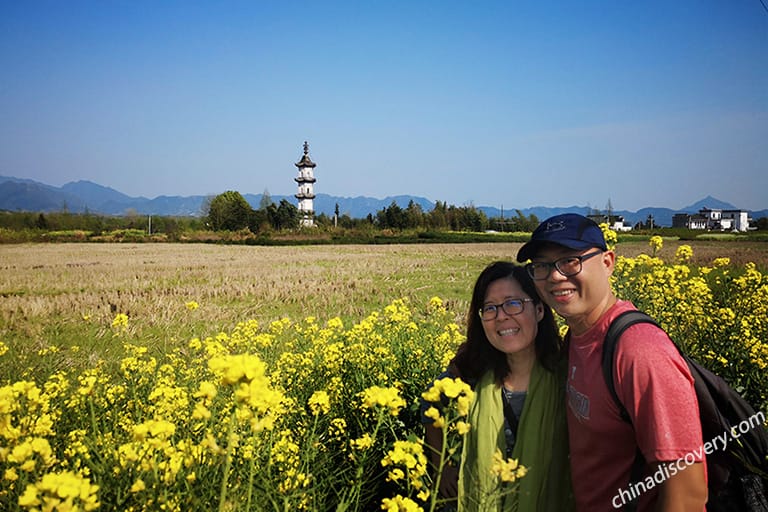Yellow Mountain - Top National Park of China
Yellow Mountain (黄山), located in Anhui Province, is also known as Huangshan Mountain, Mount Huang or Mt. Huangshan. It is a famous UNESCO World Heritage Site as well as one of the most visited scenic destinations in China.
Praised as the loveliest mountain in China, Yellow Mountain has attracted millions of travelers to enjoy its breathtaking Magical Wonders - “Odd-shaped Pines, Spectacular Rocky Peaks, Sea of Clouds, Hot Spring and Winter Snow”. As the popular ancient Chinese saying goes, "Trips to China's five great mountains render trips to other mountains unnecessary, and a trip to Huangshan renders the trips to the five great mountains unnecessary", Yellow Mountain will never disappoint any of its guests. Whenever you come, you always find visual-feast landscapes to enjoy - awesome sunrise and sunset, fantastic sea of clouds and incredible rocky peaks, beautiful pine trees, pure snow…
Huangshan Impression: Nature's Masterpiece and Timeless Culture
Main Scenic Areas in Mount Huangshan
Front Huangshan Mountain (Jade Screen Scenic Area)
Location: front of Yellow Mountain, near to Yuping Cableway Station
Recommended Visiting Time: about 3-6 hours
Main Sights: Greeting Guest Pine, Jade Screen Peak, Celestial Capital Peak, and Lotus Peak
“No visit to Jade Screen Scenic Area, no real Yellow Mountain you’ll see”. Jade Screen Scenic Area is located at the front mountain. It owns some of the most breathtaking views, including the symbol of Yellow Mountain – Greeting Guest Pine, the highest peak on the mountain – Lotus Peak (1864.8m). Another peak, Celestial Capital Peak is also very popular with hiking lovers. From Jade Screen Scenic area, one can walk directly to the central mountaintop – Bright Summit.
Back Huangshan Mountain (Beihai Scenic Area)
Location: eastern side of Yellow Mountain, near to Yungu Cableway
Recommended Visiting Time: about 2-3 hours
Main Sights: Lion Peak, Begin-to-believe Peak, Stone Monkey Watching the Sea, Refreshing Terrace
Beihai Scenic Area is a wide and open region on the top region of Yellow Mountain over 1600 meters high. It is one of the two most popular tourist centers on the mountaintop connecting Yungu Cableway. It features in lofty peaks, clouds sea, terraces, pine trees, and historical sites. Many tourists start Yellow Mountain trips from Beihai Scenic Area, and also finish here. From this area, Bright Summit and West Sea Grand Canyon are within walking distance.
 Front Mountain (Greeting Guest Pine)
Front Mountain (Greeting Guest Pine)
 Back Mountain (Stone Monkey Watching the Sea)
Back Mountain (Stone Monkey Watching the Sea)
Central Huangshan Mountaintop (Tianhai Scenic Area)
Location: in the middle of Yellow Mountain, near to Baiyun Hotel
Recommended Visiting Time: about 2 hours
Main Sights: Bright Summit, Flying-over Rock
Tianhai Scenic Area is the central mountaintop of Yellow Mountain. The second highest peak Bright Summit (1860m) dominates at the center of all other peaks. It is also the junction of all roads and paths on the mountain, where you can move to front mountain, back mountain and West Sea Grand Canyon. The famous Flying-over Rock is only 20 minutes’ walking from the Bright Summit.
West Sea Grand Canyon
Location: western side of Yellow Mountain, accessible from West Gate
Recommended Visiting Time: about 2~5 hours
Main Sights: 1st Ring, 2nd Ring, Fairy-Walking Bridge
West Sea Grand Canyon is a dreamland on Yellow Mountain, a recommended highlight of Huangshan hiking. It is also known as the Mystery Valley for its wildness and fathomless valleys. Half-day hiking starts from Dispelling Cloud Pavilion, then explores the 1st Ring and 2nd Ring, and returns to Dispelling Cloud Pavilion, which takes about 3 hours. A full-day hiking connects the hiking route from Dispelling Cloud Pavilion to the bottom (a tourist center) of the West Sea Grand Canyon to the Baiyun New Path (Three Creeks - Fairy-walking Bridge – Baiyun Hotel). The full-day hiking takes about 6~7 hours to finish.
>> 3 Days Huangshan Highlights Leisure Tour
( Please Note: from December to the middle March of next year, West Sea Grand Canyon is usually closed for the cold weather and heavy snow. From Mar. 15 of 2025, the West Sea Grand Canyon is open for travelers and you can choose to hike or take monorail for sightseeing as you like. Learn more about West Sea Grand Canyon)
 Tianhai (Flying-over Rock)
Tianhai (Flying-over Rock)
 West Sea Grand Canyon
West Sea Grand Canyon
 Hikig in the West Sea Grand Canyon
Hikig in the West Sea Grand Canyon
Yellow Mountain “Four Wonders”
Odd-Shaped Huangshan Pines
The pines in Huangshan grow over an altitude of 800 m. Among the thousands of pines, you should pay attention to the following famous ones which you may pass by.
- Guest-Greeting Pine (situated at Jade Screen Pavilion, the symbol of Mt. Huangshan, over 1000 years old)
- Farewell Pine (situated at Jade Screen Peak, its shape is like saying farewell to the guests)
- Accompany Pine (in front of Jade Screen Peak)
- Black Tiger Pine (located between North Sea to Begin-to-believe Peak)
- Leading Pine (situated at Begin-to-believe Peak)
- Phoenix Pine (south of Bright Summit, east of Central Sea Pavilion)
- Couple Pine (located between Black Tiger Pine to Begin-to-believe Pine)
- Creeping Pine (situated at Celestial Capital Peak)
- Putuan Pine (located between Jade Screen Pavilion and Lotus Gully)
Read more about Huangshan Pines: Top Pines on Huangshan
 Odd-shaped Pine
Odd-shaped Pine
Spectacular Rocky Peaks
Spectacular rocky peaks will inspire your imagination. More than 120 peaks of Yellow Mountain have got names. There are 72 high and steep peaks over 1000m with widespread grotesque rocks. The three tallest and best-known peaks are Lotus Peak, Bright Summit Peak and Celestial Capital Peak.
Within the area, the towering peculiar peaks are majestic and fantastic and the rocks in the grotesque shapes seem to be a work of carving. The names of the stones and rocks are very interesting and legendary. Some are like birds and animals, including Squirrel Jumping at the Celestial Capital Peak, Rhinoceros Watching the Moon, Stone Monkey Watching the Sea, etc. Some are like human-beings, including Immortal Solarizing the Boot, Immortal Walking on Stilts, etc. Some are like different kinds of stuff, including the Pen Flower Peak, Pen Rack Peak, Flying over Rock, etc. Some are named after Chinese stories and legends, like Su Wu Tending the Sheep Peak, Taibai Drunk Peak, etc. When appreciating the rocks and peaks, you should open your imagination and enjoy.
Celestial Capital Peak
Celestial Capital Peak is at an altitude of 1810m, one of the 36 peaks of Yellow Mountain. It is called the most thrilling peak of Mt. Huangshan. It is about 1 km south from Jade Screen Peak.
Lotus Peak
Lotus Peak is the highest peak at 1864 km, southwest of Jade Screen Peak. Its shape resembles a blossoming lotus. From the apex, travelers can view thousands of peaks and numerous ravines in the misty clouds. On a sunny day, travelers can even find Tianmu Mountain in the east, Mount Lu in the west, Mount Jiuhua in the north. When climbing Lotus Peak, you can see many love locks locked forever on the iron chains on the cliff. They are mostly left by affectionate lovers who hope their love will stay forever.
Begin to Believe Peak
In the Ming Dynasty (A.D. 1368 - 1644), the famous traveler Xu Xiake (徐霞客) advocated that Yellow Mountain was the most beautiful mountain after he returned from a Yellow Mountain trip. Many people agreed. But an official in the Qing Dynasty (A.D. 1644 - 1911) doubted that. So he decided to have a look at Yellow Mountain with his own eyes. And right after seeing the stunning landscapes at where the Begin-to-Believe Peak now stands, he began to believe that the Yellow Mountain truly was the most beautiful mountain. That’s how the peak gets its name.
Lion Peak
As its name implies, the Lion Peak really looks like a crouching lion with the summit as its head, Refreshing Terrace as its waist and Dawn Pavilion as its tail. It is only about 20 minutes’ walking from Beihai Hotel. The Refreshing Terrace is believed to be the best location for watching sunrise.
Bright Summit
The Bright Summit is the second highest peak on Yellow Mountain with an altitude of 1860 meters. It is located at the central point of all peaks, which makes it an ideal location for a panoramic view of Yellow Mountain. From the summit, one can easily navigate to both the front mountain and back mountain of Yellow Mountain. It is also a great location for both sunrise and sunset.
 Spectacular Rock Peaks
Spectacular Rock Peaks
 Begining-to-belive Peak
Begining-to-belive Peak
 Celestial Capital Peak
Celestial Capital Peak
 Bright Summit
Bright Summit
Sea of Clouds
Geographically, Huangshan Mountain can be divided into five sea areas. The south of Lotus Peak and Celestial Capital Peak is South Sea, also called Front Sea. The north of Lion Peak and Begin-to-believe Peak is North Sea, also called Back Sea. The east of White Goose Ridge Peak is called East Sea and the west of Purple Cloud Peak and Flying over Peak is the West Sea. The front of Bright Summit is Heavenly Sea. Normally, the best time to enjoy sea of clouds is from November to the next May, especially after snow and rain. It is magnificent before the sunrise and after the sunset. You should never miss this spectacular scene.
Best Places to View Sea of Clouds: Jade Screen Pavilion to see South Sea; the Refreshing Terrace to see North Sea; White Goose Ridge to see East Sea and Cloud Dispelling Pavilion to see West Sea and Bright Summit to see Heavenly Sea.
Winter Snow
Usually, the winter in Mt. Huangshan is from November to March. During this period, Yellow Mountain is as beautiful as silver fairyland when the peaks, the oddly-shaped rocks and the trees are all covered by a white blanket. Here is how an ancient Chinese poem describes it “With ice columns skyrocketing into the sky, and pure snowflakes blooming on the pine, Huangshan Mountain in winter is the snowy heaven on earth.”
In the early mornings in winter, the newborn sun spreads its rosy lights on the surface of clouds sea. Early sunlight rests gently on the shoulders of Mt. Huangshan, casting a golden hue over the snow-capped valley. With sunlight dancing cheerfully in the mountains, Yellow Mountain presents a splendid picture. If lucky, you can appreciate the “Buddhist Light”, a full-circle rainbow. The optical phenomenon can frequently be seen on Yellow Mountain after a snowfall.
The best locations to view snow scenery of Yellow Mountain are Celestial Capital Peak, Lotus Peak, Xihai Grand Canyon, Jade Screen Peak, Cloud Valley Temple, etc.
>>Yellow Mountain in Winter: Weather, Temperature, Scenery & Travel Tips
>>4 Days Huangshan Hongcun Vacation with Hot Spring
Read more about Huangshan: 11 Facts About Huangshan (Yellow Mountain)
 Sea of Clouds near Lion Peak
Sea of Clouds near Lion Peak
 Winter Snow
Winter Snow
 Winter views from Lion Peak
Winter views from Lion Peak
Best Places to Watch Huangshan Sunrise & Sunset
Sunrise
Locations: the Refreshing Terrace, Dawn Pavilion, Lion Peak, Begin-to-believe Peak, Purple Cloud Peak, Bright Summit, Turtle Peak, Jade Screen Pavilion, etc. Among them, the best locations are Refreshing Terrace, Lion Peak and the second best locations are Bright Summit and Jade Screen Pavilion.
Referral Time to Watch Sunrise: in spring during 05:30-06:00; in summer during 04:40-05:10; in autumn during 04:50-06:20, in winter during 05:30-06:00.
Recommended Hotels to Stay: Stay at Beihai Hotel to watch sunrise at Lion Peak, Refreshing Terrace; stay at Xihai Hotel or Paiyunlou Hotel to watch sunrise at Purple Cloud Peak, you need to hike 15 minutes there; stay at Baiyun Hotel to watch sunrise at Bright Summit and Turtle Peak.
>>Huangshan/Yellow Mountain Sunrise: Time, Recommended Spots and Hotels
Sunset & Sunglow
Locations: travelers can watch sunset at Cloud Dispelling Pavilion, Purple Cloud Peak, Flying over Rock, Bright Summit, Lotus Peak, etc. The best is Cloud Dispelling Pavilion at West Sea.
Referral Time to Watch Sunset: in spring during 18:00-19:00; in summer during 18:30-19:20; in autumn during 17:30-18:45; in winter during 17:00-17:35.
>>Huangshan/Yellow Mountain Sunset: Time, Viewing Spots, nearby Hotels & Tips
Detailed Sunrise and Sunset Time for your Reference, please check the following chart.
 Sunrise over Huangshan
Sunrise over Huangshan
 Sunrise over Huangshan
Sunrise over Huangshan
 Sunset
Sunset
| Date | Daybreak | Sunrise | Sunset |
|---|---|---|---|
| Jan 21 | 06:37 | 07:03 | 17:35 |
| Feb 21 | 06:17 | 06:42 | 18:00 |
| Mar 21 | 05:46 | 06:10 | 18:19 |
| Apr 21 | 05:10 | 05:35 | 18:38 |
| Mar 21 | 04:45 | 05:11 | 18:57 |
| Jun 21 | 04:38 | 05:06 | 19:11 |
| Jul 21 | 04:52 | 05:19 | 19:07 |
| Aug 21 | 05:13 | 05:38 | 18:40 |
| Sep 21 | 05:30 | 05:45 | 18:45 |
| Oct 21 | 05:48 | 06:12 | 17:30 |
| Nov 21 | 06:12 | 06:37 | 17:09 |
| Dec 21 | 06:33 | 06:59 | 17:12 |
( Please Note: the above sunrise and sunset time are for your reference. To know the exact time of your travel date, please feel free to ask details from your tour guide or the hotel you stay.)
Recommended Huangshan Visiting Route
 Yellow Mountain Tourist Map
Yellow Mountain Tourist Map
Classic Route:
Day 1 Huangshan arrival and stay in Huangshan downtown area;
Day 2 Transfer to Mt. Huangshan, take Yugu Cableway to get up and visit Pen Flower Peak, Black Tiger Peak, Refreshing Terrace, Lion Peak, Stone Monkey Watching the Sea, watch sunset at Cloud Dispelling Pavilion and enjoy part of West Sea Grand Canyon, stay at the summit of Yellow Mountain; (It needs about 5 hours’ hiking this day)
Day 3 Watch sunrise over Lion Peak (or Purple Cloud Peak, Bright Summit), visit Flying over Rock, Bright Summit, Beginning-to-Believe Peak and take cable car at White Goose Ridge Station to Yungu Station and take sightseeing bus to get down Yellow Mountain. After the trip in Mt. Huangshan Scenic Area, transfer to visit Tunxi Ancient Street and Hu Kaiwen Ink-stick Factory before get departure.
Please go and check: >> 3 Days Huangshan Highlights Tour
Extension: for those who want to visit Xidi and Hongcun Ancient Villages, you can spend one day going to the UNESCO ancient villages. You can put it before or after the Huangshan Mountain visit.
Please go and check:
>> 4 Days Best Huangshan Tour with Hongcun & Xidi Ancient Villages
>> 4 Days Huangshan Tour to Huizhou Culture Exploration
Popular Hiking Route:
For hiking lovers, it is necessary to spend at least two days on the mountain to explore both the Front Mountain (Greeting Guests Pine, Lotus Peak, One-Line Sky…) and the Back Mountain (Begin-to-Believe Peak, Lion Peak). Generally, there are three major hiking routes in Huangshan – the western route, eastern route and West Sea Grand Canyon Hiking: 1) Western Route (Mercy Light Pavilion – Greeting Guest Pine – Lotus Peak – Bright Summit); 2) Eastern Route (Yungu Temple – White Goose Ridge – Begin-to-Believe Peak – Lion Peak – Bright Summit); 3) West Sea Grand Canyon. It is suggested to stay at least for one night on the mountain so that you can have enough time to take in all of the sights this beautiful mountain has to offer. But if you have only a day for the Yellow Mountain, or may not be able to find a place to stay in tourist peak season, you can also do the hiking in just a day as long as you start early and take cableways as transfer on the mountain.
 Tour Huangshan
Tour Huangshan
 Hiking in Huangshan
Hiking in Huangshan
 Sunglow
Sunglow
How to Get to Yellow Mountain
There are some ways to get to Huangshan city. Travelers can go by air, high speed train, normal train, long distance bus. There are flights from Shanghai, Beijing, Chengdu, Xian, Xiamen, Chongqing, Hefei, Guangzhou, etc. High speed trains are connecting Huangshan with Shanghai, Hangzhou, Hefei, Beijing, Xiamen, Jinan, etc. It is recommended to go from Shanghai to Huangshan by high speed train with 3.5 hours’ transfer. From Huangshan downtown area, it needs about 1.5 hours to Mt. Huangshan Scenic Area. How to Get to Yellow Mountain >>
Useful Travel Tips
1. Yellow Mountain Four Seasons & When to Go
Yellow Mountain changes its color and appearance with the alternation of seasons. It is hard to say the best season to visit Mount Huangshan. Different season has different subjects. In spring, the mountains feature various colors, the flowers blossom and the streams gurgle through the quiet valleys. In summer, it turns a green world and photographers shoot peaks rising one upon another. In autumn, the mountains dress in red and golden. In winter, Mount Huang turns into a world of frost and ice with silver boughs and rocks in all the scenic areas. There are about 50 days in a year capped by snow. The first snow begins in the late November and the last snow may occur in the late March.
2. Cableway - Getting Up the Yellow Mountains
(a) Yungu Cableway: Yungu Temple – White Goose Ridge Station
Ticket: 80 Yuan per person per way
Running Hours: 07:00-17:00
Duration:8 minutes per way for 2566m
Sights along the way:Celestial Capital Peak, Lotus Peak, The Immortal Pointing the Way, etc.
(b) Yuping Cableway: Mercy Light Temple - Jade Screen Pavilion
Ticket: 90 Yuan per way
Running Hours: 07:00-17:00
Duration:10 minutes per way for 2176m
Sights along the way:Mercy Light Temple, Holy Spring Peak, Three-Island at Penglai, Jade Screen Peak,
(c) Xihai Sightseeing Cableway: Pai Yunxi Station - Tianhai Station
Ticket: 100 Yuan per person
Running Hours: 08:00-17:00
Duration:5 minutes for 893m
Sights along the way:West Sea Grand Canyon, Cloud-dispelling Pavilion, Flying Over Rock
(d) Taiping Cableway: Pine Valley Station – Red Cloud Station
Ticket: 80 Yuan per person
Running Hours: 07:00-17:00
Duration: 8 minutes per way for 3709m
Sights along the way:Bright Summit, Nine Dragon Peak, Bookcase Peak, Cock Peak and Red Cloud Peak, etc.
>>Huangshan Cable Car: Yungu, Taiping, Yuping & Xihai Cableways
3. Distance between each scenic spot
| Sights | Distance |
|---|---|
| Tangkou – Front Gate | 1 km |
| Front Gate – Hot Spring | 1.5 km |
| Hot Spring – Mercy Light Temple | 1.5 km |
| Mercy Light Temple – Halfway Temple (Banshan Temple) | 2.5 km |
| Halfway Temple – Foot of Celestial Capital Peak | 2.5 km |
| Foot of Celestial Capital Peak – Jade Screen Pavilion | 1 km |
| Foot of Celestial Capital Peak - Celestial Capital Peak | 1.5 km |
| Jade Screen Pavilion – Foot of Lotus Peak | 2.5 km |
| Foot of Lotus Peak – Lotus Peak | 1.5 km |
| Foot of Lotus Peak – Bright Summit | 2.5 km |
| Bright Summit – Baihai Hotel | 2.5 km |
| Beihai Hotel – Cloud Dispelling Pavilion | 2.5 km |
| Beihai Hotel – Begin-to-believe Peak | 1 km |
| Beihai Hotel – Pine Valley Nunnery | 10 km |
| Beihai Hotel – Pine Valley Nunnery | 1.5 km |
| Emerald Pool – Lotus Pool | 1.5 km |
| Yungu Temple – The Immortal Pointing the Way | 4 km |
| The Immortal Pointing the Way – North Sea | 3.5 km |
4. Closed Scenic Spots in Winter
During the cold winter usually from December to March next year, West Sea Grand Canyon, Lotus Peak, Celestial Capital Peak will be closed then every year.
5. What to Pack
- Wear comfortable shoes for there are lots of stairs to climb;
- Bring two bottles of water and some food;
- Take some emergency medicine;
- Take raincoat for the weather changes a lot in Mt. Huangshan; you’d better not take umbrella for the wind is very strong.
- Suggest to take sunhat, sunglasses, walking stick.
>>Packing list - What to Pack for A Huangshan Hiking Tour
6. Safety Notice
Your safety is the first priority. When enjoy the beautiful mountains view, spectacular peaks, or sea of clouds, please watch out your steps.
How to Plan a Huangshan Yellow Mountain Tour
You can easily plan your Yellow Mountain trip to 1 day, 1.5 days, 2 days, 3 days or more according to your days, energy condition and interest. If you just want to explore Huangshan in an easier way, 3 Days Huangshan Highlights Tour will be the best choince. 3 Days Huangshan Classic Hiking Tour is a little more physical demanding than the previous one, but you will be rewarded with the stunning scenery of both back and front mountain. If you are also interested in the local lives and cultures, then you can check this 4 Days Best Huangshan Tour with Hongcun & Xidi Ancient Villages. Hongcun and Xidi Ancient Village are together listed as UNESCO World Heritage Sites.
Huangshan can be traveled with other popular China destinations easily especially those in the nearby regions, such as Shanghai, Suzhou, Hangzhou, Jingdezhen, Wangxian Valley, etc. You can even connect Huangshan with Beijing, Xian, Guilin, Zhangjiajie, Chengdu, etc.
We have helped many global travelers enjoy their memorable trips to Huangshan for the past few years. Among them, a couple from Canada enjoyed their romantic 14-day Nature & Culture China trip covering Huangshan highlights with our cutomized tour package. Besides, Mr. Ban's group from USA who have been traveling with us for more than 3 years also savored the sightseeing and culture of Huangshan.
All of our Huangshan tours can be tailor-made to fit your needs and likes. You will also be well taken care of by our local knowledgeable and helpful tour guide and experienced private drivers, and enjoy well-selected quality accommodation and food. Please feel free to contact us with your requirements or questions and our professional travel consultant will reply to you as soon as possible.
Other Recommended Tours:
 Tour Huangshan
Tour Huangshan
 Hiking in Huangshan
Hiking in Huangshan
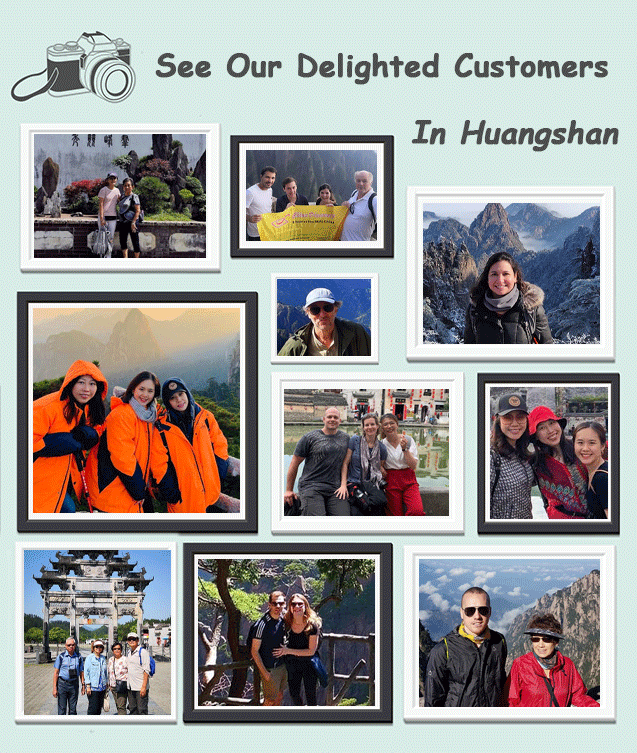 Sunglow
Sunglow
Top Attractions in Huangshan
- West Sea Grand Canyon
- Hongcun Ancient Village
- Xidi Ancient Village
- Tunxi Ancient Street
- Hu Kaiwen Ink Factory
- Tangyue Memorial Archways
- Bao Family's Garden
- Huizhou Ancient City
- Chengkan Village
- Nanping Village
- Bishan Village
- Tachuan Village
- Lucun Village
- Guanlu Ancient Street
- Tangmo Ancient Village
- Mukeng Bamboo Forest
- Xinan River Landcape Gallery
- More Attractions in Huangshan
Extension Readings of Huangshan Travel Guide
- How to Plan Mount Huangshan Tour
- What to See on Yellow Mountain
- Activities in Huangshan
- Yellow Mountain Hotels
- Huangshan City Hotels
- Tangkou Hotels
- Huangshan Maps
- Best Time to Visit Huangshan
- Huangshan Transfer Guide
- What to Pack
- Huizhou Culture
- Huangshan Cuisine
- Huangshan Travel FAQs & Tips
- Huangshan Itinerary
- Huangshan Photo Gallery
- All Huangshan Travel Guide
Recommended Huangshan Tours
Top 3 Huangshan tours chosen by most customers to explore Huangshan in the best way. Check the detailed itinerary, or tailor your own trip now with us.

3 Days Huangshan Highlights Leisure Tour (Back Mountain + West Sea Grand Canyon)
Tunxi - Huangshan - Tunxi

4 Days Best Huangshan Tour with Hongcun & Xidi Ancient Villages
Tunxi - Huangshan Mountain - Hongcun - Xidi

4 Days Huangshan with Pig's Inn Carefree Countryside Idyll Tour
Huangshan - Hongcun - Bishan
Start planning your tailor-made holiday to China by contacting one of our specialists. Once inquired, you’ll get a response within 0.5~23.5 hours.
Customize a TripHave a question? Get answers from our travel experts or guests
- Your Question:
- Your Name:
- Your Email:
- Submit



























